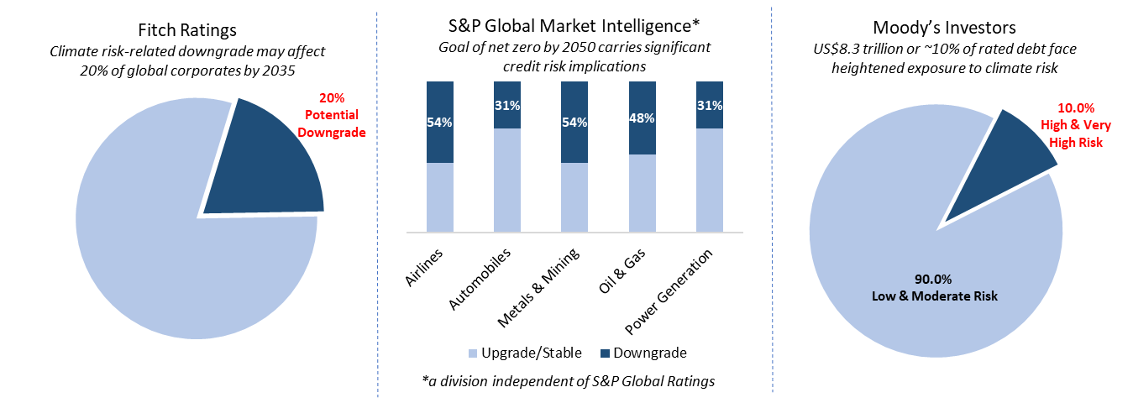Rating stability at risk from looming climate downgrades

Key Findings
Credit ratings are underplaying climate-related risks. This trend should be of grave concern to bond market participants who value stability.
The three big firms (Fitch Ratings, S&P Global Market Intelligence, Moody’s Investors Service), or their independent divisions, have been cautioning about the impact of climate-related risks on credit ratings. Their announcements are signaling that the accumulating climate risks, though yet to result in tangible and predictable effects, will likely lead to rating volatility and instability, a costly affair for investors and issuers.
Can a long-term investment-grade bond maintain its relatively robust status five years or more from today, if the rating system keeps the status quo? It seems unlikely particularly for hydrocarbon-dependent issuers, following the warning signs flagged by the rating agencies.
While incorporating climate risks does not entirely mitigate rating volatility, at the very least it should be accounted for. Regulators have the power to enable real and tangible action.
Credit ratings are underplaying climate-related risks. This trend should be of grave concern to bond market participants who value stability.
Alarm bells have been sounding for months, and from within the rating industry itself. One of the latest to press home the message was the Global Head of ESG in Credit at S&P Global Ratings, who underscored in a June article the potential for climate-related risks to become significant drivers affecting creditworthiness, an impact that was expected to accumulate over time.
The article also revealed that S&P had taken “very few climate-related rating actions since early 2022… due to the growing gap between policy pledges and the tangible effects of regulations, as well as companies’ so far limited spending on investments to align with a net-zero world.”
There is truth to these statements, and what is more, the article basically confirms that climate risks which are unaccounted for and yet growing will inevitably lead to unstable ratings – a problem for bond markets that could be avoided if the warnings are heeded.
Trouble is brewing for bond investors
The big three firms or their independent divisions have been cautioning about the impact of climate-related risks on credit ratings.
In March, Fitch Ratings indicated that about 20% of global corporates – mainly oil and gas producers, and pipeline and energy midstream companies – could be downgraded by 2035 due to exposure to climate vulnerabilities.
Two months earlier, S&P Global Market Intelligence found in a scenario analysis of an orderly energy transition by 2050 that companies operating in five major carbon-intensive sectors – airlines, automotive, metals and mining, oil and gas, and power generation – faced a 31%-54% downgrade risk. A disorderly transition would raise the credit downgrade risk further by 2%-20%, which suggested more severe financial and credit risk implications, particularly for power generation and oil and gas.
Last October, Moody’s Investors Service reported that credit risks associated with environmental considerations were rising and that sectors with high or very high inherent climate risk – including oil and gas, automobile manufacturers, utilities and power generation – accounted for 10% of total rated debt outstanding. These sectors were similar to those later identified by Fitch and S&P. The risk was expected to exacerbate as the low-carbon economy transition gained traction and the negative effects of physical climate change deepened.
These announcements went largely unalarmed, and this is concerning.
The announcements are signaling that the accumulating climate risks, though yet to result in tangible and predictable effects, will likely lead to rating volatility and instability, a costly affair for investors and issuers. Investors would need to transact the same securities with greater frequency, while regulated institutions would have to more closely manage their asset-liability risks and provide for significantly higher capital buffers so as not to be caught out by a sudden downgrade. Issuers would face greater refinancing cost by raising more debt or pledging more collateral.
As highlighted in an IEEFA report in March, this could result in multi-notch downgrades and trigger sweeping bond sell-offs. A financial time bomb is ticking.

Source: Fitch Ratings, S&P Global Market Intelligence, Moody’s Investors Service and IEEFA’s compilation
A call for regulators to aid proactive resolutions
Credit rating firms have been adapting and improving their market signaling since the global financial crises. Now, they are highlighting the imminent impact of climate risks. But real action on ratings is still largely absent due to credit assessments that are reactive, rather than proactive, partly because of regulatory requirements.
Regulation requires rating methodologies to be supported by historical data and statistical evidence. While this is important to maintain the robustness of a model’s performance, regulators should also facilitate the evolution of rating methodologies.
Specifically, IEEFA proposes asking agencies to adopt near-term and forward-looking alternatives, for example, by forecasting future earnings or impact on cash flows from a climate risk perspective, through instituting a standalone climate risk assessment and a double rating analysis. This would also foster better alignment with the European Central Bank’s recommendations to require rating firms to disclose the magnitude of adjustments to credit rating methodology as a result of material climate-related risk.
Regulators should also require credit rating committees to include non-voting independent climate specialists as members, to enhance the committees’ capabilities and capacity when making the final decision on a credit rating. It is not uncommon for rating committees to bring sector-specific credit experts on board, and climate professionals would make a worthy addition. The growing climate risks – and the novelty of such risks in the rating system – necessitates the involvement of a dedicated specialist in this domain.
Playing the waiting game is risky
Can a long-term investment-grade bond maintain its relatively robust status five years or more from today, if the rating system keeps the status quo? It seems unlikely particularly for hydrocarbon-dependent issuers, following the warning signs flagged by the rating agencies.
Unfortunately, the wait-and-see approach to integrating climate risks has been the default mode. Credit assessments consider uncertain forward-looking climate risks only when these become visible and certain, by which time it could be too late. The need for a more sustainable, relevant and effective credit system is now.
While incorporating climate risks does not entirely mitigate rating volatility, at the very least it should be accounted for. Regulators have the power to enable real and tangible action.















